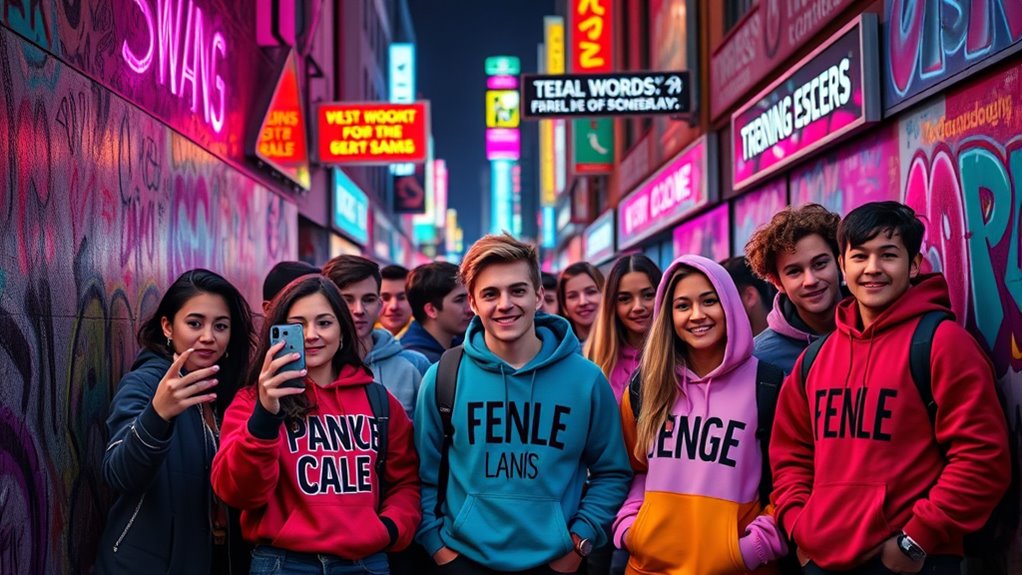Teenagers constantly invent new words to express their identity and stand out among peers. Digital platforms like TikTok, Instagram, and messaging apps make it easy for these slang words to spread worldwide almost instantly. Viral trends quickly reach millions, breaking down borders and making language evolution faster than ever. This rapid spread helps teens feel connected and culturally in sync. If you keep exploring, you’ll discover how technology keeps driving these language changes forward.
Key Takeaways
- Teenagers create new words to express their identity, emotions, and social belonging uniquely.
- Digital platforms like TikTok and Twitter enable rapid sharing and viral spread of slang worldwide.
- The speed of online communication allows slang to evolve and reach global audiences within minutes.
- Creating slang helps teens differentiate their peer groups and stay culturally relevant.
- Multimedia content amplifies new slang, making it more memorable and appealing across digital communities.

Have you ever wondered how teenagers come up with new words that quickly catch on? It’s fascinating to see how slang evolution happens so rapidly among young people, especially in today’s digital communication era. You might think that language changes slowly over generations, but for teenagers, it’s almost instant. They’re constantly creating and adapting words to fit their evolving culture, identity, and social dynamics. Digital communication—texts, social media, messaging apps—plays a huge role in this process. It provides a fast, accessible platform for sharing these new terms with friends and, eventually, the world. When a teenager coins a catchy phrase or slang term, it can spread across online communities in minutes, reaching millions overnight.
Teenagers rapidly spread new slang through digital platforms, making language evolution faster than ever before.
In the past, slang evolved gradually through face-to-face interactions or local communities. Now, digital communication accelerates this process exponentially. A new phrase or word can go viral on TikTok, Twitter, or Instagram, and suddenly, it’s part of global youth language. This rapid dissemination is made possible because digital platforms break down geographical barriers, allowing teenagers from different countries to share and adopt slang instantly. Plus, the visual and multimedia nature of social media helps amplify new words, making them more memorable and appealing. Additionally, the use of high-tech communication tools allows for rapid testing and feedback on new slang, further fueling their spread.
Teenagers are constantly inventing new words because they want to stand out, express their feelings, or simply have fun. Language is a tool for identity, and creating slang allows young people to carve out their own social space. It’s also a way to bond with friends and show belonging within their peer groups. When a new word catches on, it becomes a badge of cultural literacy among teens, signaling that you’re “in the know.” As these words spread, they often evolve or combine with existing slang, creating new layers of meaning.
Moreover, digital communication makes it easier than ever to test out new words and see how others react. If a term resonates, it gets shared again and again, becoming part of the online lexicon. This constant cycle of creation and adoption fuels the ongoing slang evolution. It’s a dynamic process that reflects teenagers’ desire to stay fresh, relevant, and connected in a fast-paced digital world. So, next time you see a new slang term trending online, remember—it’s a product of teenagers’ inventive spirit, driven by the immediacy and reach of digital communication.
Frequently Asked Questions
How Do Teenagers Decide Which New Words to Use?
You decide which new words to use based on teen slang origins and peer influence. When a slang term emerges within your social circle, you’re more likely to adopt it if your friends use it often. Peer influence plays a huge role, as you’re motivated to fit in and stay current. If a word resonates with your identity or feels fun, you’ll probably start using it, helping it spread quickly among teenagers worldwide.
Do Schools Influence Teenagers’ Word Inventions?
You might think schools influence teen slang origins, but peer influence plays a bigger role. Schools often don’t directly shape new words; instead, you pick up slang from friends and social media. When your friends start using a word, you’re more likely to adopt it. This peer influence helps slang spread rapidly, making it a key driver behind the ever-evolving language teenagers invent and share.
How Long Do New Slang Terms Typically Last?
Ever wonder how long slang stays fresh? In the world of linguistic evolution, slang longevity varies wildly. Some terms vanish in weeks, while others stick around for years. It’s a constant cycle of innovation and fade-out, driven by social trends and digital culture. As a teen, you might notice your favorite slang fading faster than you expect—yet some words become timeless, shaping language for generations.
Can New Words Impact Formal Language and Communication?
You might wonder if new words impact formal language and communication. They can influence linguistic evolution, introducing fresh expressions that eventually seep into official contexts. However, this process often challenges language preservation, risking the loss of traditional terms. While slang can make language more dynamic, it’s essential to balance innovation with clarity, ensuring that formal communication remains precise and universally understandable as language continues to evolve naturally.
What Role Do Cultural Trends Play in Word Creation?
You might think cultural trends just influence fashion, but they also drive new word creation. Cultural influences shape how slang evolves, reflecting shared experiences and values. As global slang adoption spreads, these words become part of everyday language, transcending borders. This interconnectedness accelerates language change, making it more dynamic and diverse. So, cultural trends are powerful catalysts for creating fresh words that resonate worldwide, shaping communication for generations to come.
Conclusion
Just like a spark that ignites a wildfire, your words can spread rapidly across the globe, fueled by social media and shared experiences. When teenagers invent new terms, it’s as if they’re planting seeds of language that grow and evolve overnight. You’re part of this vibrant, evolving landscape—creating a ripple effect that reaches far beyond your immediate circle. So keep innovating; your words have the power to shape the world’s language, one spark at a time.










